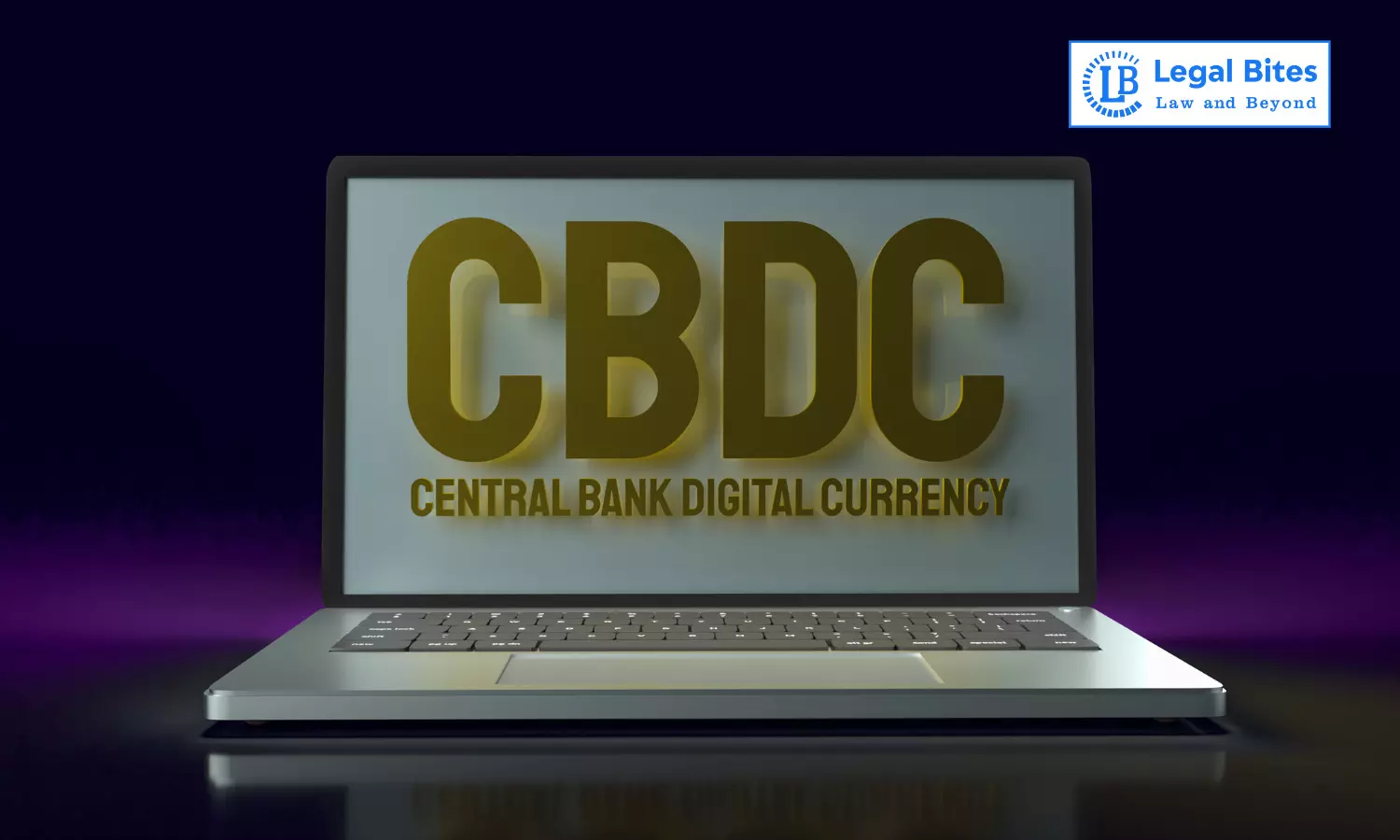RBI's new digital rupee: know about CBDC and how it differs from Cryptocurrencies?
The article 'RBI's new digital rupee: know about CBDC and how it differs from Cryptocurrencies?' by Snehil Sharma intends to explore the facets of Central Bank Digital Currency (CBDC) which has been recently introduced and how it will be duly implemented in the Indian Scenario.

The article 'RBI's new digital rupee: know about CBDC and how it differs from Cryptocurrencies?' by Snehil Sharma intends to explore the facets of Central Bank Digital Currency (CBDC) which has been recently introduced and how it will be duly implemented in the Indian Scenario. It will further analyze and throw light upon how Central Bank Digital Currencies are a more reliable and secure option than Cryptocurrencies.
Money has a fascinating history that dates back thousands of years. It has always had a significant impact on how our society functions, starting with the early days of trading and continuing through the introduction of the first metal coins and then the first paper money. The Reserve Bank of India (RBI) emerged as one of the first major central banks in the world to begin a pilot project with its own virtual currency. In this pilot project, the wholesale digital rupee will be used on a trial basis starting from 1st November 2022, initially for the settlement of transactions in government securities.
Introduction
As part of their phased implementation approach, the RBI released a concept note exploring the advantages and disadvantages of establishing Central Bank Digital Currencies (CBDCs) in India.
The Central Bank Digital Currencies (CBDCs) are the most pervasive innovation in the digital payments arena that has the potential to fundamentally affect all participants in the global financial services business. A Central Bank Digital Currencies (CBDCs) is both an innovation in the way that money is issued as well as the underlying infrastructure upon which payments can be made.
CBDCs are being developed by numerous nations, and some have even put them into practice. Understanding digital currencies and what they signify for society, therefore, becomes crucial as many nations are looking at how to make the transition to digital currencies.
Central Bank Digital Currency: Conceptual Insight
The Central Bank Digital Currency (CBDC) is a brand-new currency that was introduced to solely exists in digital form. To make digital transactions and transfers easier, the Central Bank creates widely accessible digital coins instead of issuing physical currency. This government-issued currency is one that is not backed by a tangible commodity like gold or silver. It can be regarded as a type of accepted legal tender for the exchange of goods and services. Banknotes and coins served as the traditional forms of currency, but technological advancements have made it possible for governments and financial institutions to replace the physical form of fiat money with a credit-based system in which balances and transactions are maintained digitally.
Although physical currency is still extensively accepted and exchanged, its use has significantly declined in several developed nations, a tendency that increased during the COVID-19 epidemic.
Recent Upsurge in CBDC
CBDC efforts have expanded globally for a variety of reasons. First, the COVID-19 problem hastened the decrease of cash exchange by causing a shift in payment habits toward digital, contactless payments, and e-commerce in response to the refuted threat of infection spread by banknotes. Second, cryptocurrencies introduced by unauthorized organizations or private companies have experienced tremendous growth and value boosts. In response, eighty-seven nations—representing over 90% of the world's GDP—are presently investigating central bank digital currencies, and nine of them have already completely implemented a state-owned digital currency.
Methods of Introducing CBDC
CBDC can be introduced in different methods i.e. centralized and decentralized methods. A centralized approach involves recording transactions in ledgers that are overseen by central banks that also offer user-facing services. On the other hand, in the decentralized method, the central bank establishes guidelines and specifications with regard to the settlement of CBDC transactions, which are then further recorded by users and/or financial intermediaries.
How any CBDC is implemented also determines the impact of such currency. Conventional currency inhabits various intermediaries at different levels within the payment chain. This eventually leads to a payment experience that is less secure as well as efficient. Proper implementation of CBDC in the payment arena will provide solutions to these problems, as it is intended to provide a secure, efficient, faster, and more sovereign form of the payment process.
CBDC in India
One of the RBI's primary central banking duties is managing currency, for which Section 22 of the RBI Act, of 1934 grants it legal authority. The Reserve Bank, along with the Government of India, is in charge of the development, production, and general administration of the country's currency with the aim of guaranteeing an adequate supply of authentic and clean notes throughout the economy.
The launch of a digital rupee issued by the RBI was announced for the first time, by finance minister (FM) Nirmala Sitharaman in February of this year when presenting the budget for the year 2022–2023. The central bank digital currency (CBDC), according to the FM, was supposed to significantly stimulate the digital economy as the most advanced technologies will be utilized in digital currency's currency management system making it more effective and affordable.
Finally, a concept note outlining the goals, prospects, advantages, and risks of issuing Central Bank Digital Currencies (CBDC), or e (digital rupee), in India was released by the Reserve Bank of India (RBI) on 1st November 2022.
Purpose of India's CBDC
To raise awareness of CBDCs in general and the proposed features of the digital rupee in particular, this concept note was issued. The note aims to describe RBI's strategy for introducing the CBDC. It further explains the goals, options, advantages, and risks of India's CBDC issuance. Important factors like technology and design options, potential applications for digital rupee, and issuance methods are also covered in the RBI's concept note. It analyses privacy concerns and looks at how the adoption of CBDC will affect the banking system, monetary policy, and financial stability.
Classification of India's CBDC
According to the central bank's paper, CBDC can be divided into two major categories: general purpose or retail (CBDC-R) and wholesale (CBDC-W). The recent pilot project was introduced to use CBDC in the wholesale market for secondary trade in govt. securities. RBI will shortly begin experimental launches of e-rupee for specific use cases in the upcoming months. The first trial in the Digital Rupee - Retail category will debut in a few key locations with closed user groups made up of consumers and retailers.
Participating Banks
Nine banks in total, are participating in the first pilot project which was introduced on 1st November by RBI. These banks include the State Bank of India, Yes Bank, Bank of Baroda, Union Bank of India, HSBC, IDFC First Bank, HDFC Bank, ICICI Bank, and Kotak Mahindra Bank.
CBDC v. Cryptocurrency: Point of Difference
After the introduction of CBDC, it is very crucial to understand the difference between CBDC and Cryptocurrency as it seems to be similar in the first instance. They some way or another other sprang from blockchain technology, and have some fundamental traits in common, but also differ greatly from one another.
A cryptocurrency is a form of digital asset that recently got into the limelight. It functions as a virtual storage of value and a medium of exchange in a decentralized network. This implies that there is no specific central governing authority that will be having an eye on such assets. This is the biggest backdrop of cryptocurrencies and it has been primarily controversial due to this sole reason of being decentralized. Transactions involving cryptocurrencies are kept on a blockchain, which is merely a publicly distributed ledger. All the information about every transaction conducted on the network is stored in this ledger. A copy of this ledger can be saved on the system by users who volunteer to become nodes. This ledger is open to all other users, allowing them to see every transaction that is recorded there.
The CBDC on the other hand serves as a form of value storage and can be applied to digital purchases of products and services. They are issued and managed by a country's central bank (RBI in the Indian scenario). Blockchain technology is also used by CBDCs to store and verify transaction data. They do, however, work on a personal and restricted network. As a result, the general public won't be allowed to participate in the verification process and won't be given access to transactional data. Instead, the central bank selects the nodes that will take part in the verification process. Banks and other financial institutions that support system transactions will most likely be these nodes.
The value of Cryptocurrency keeps fluctuating regularly since it is managed privately. Due to government backing, the CBDC will also have an intrinsic value, making the possession of a digital rupee the same as holding a physical rupee. This eventually brings the CBDC in a stronger position as compared to Cryptocurrency.
Conclusion
The RBI has been committed to examining the benefits and drawbacks of a central bank digital currency and is developing a plan to roll it out gradually. CBDC can turn out as a game changer since it has the ability to improve the efficiency and security of the financial transaction settlement systems. Given their distinct potential, it could be even more beneficial to introduce both wholesale (CBDC-W) and retail (CBDC-R) together in the coming future.
References
[1] Central Bank Digital Currencies: Building Block of the future of Value Transfer, Available Here
[2] Central Bank Digital Currency, Available Here
[3] Concept Note on Central Bank Digital Currency, Available Here
[4] RBI shares concept note on Digital Rupee or Central Bank Digital Currency, Available Here
[5] Sangeeta Ojha, Explained: What is Digital Rupee?, Available Here
[6] Basudha Das, Cryptocurrency vs CBDC vs Digital Money: What's the difference? , Available Here
Important Links
Law Library: Notes and Study Material for LLB, LLM, Judiciary, and Entrance Exams

